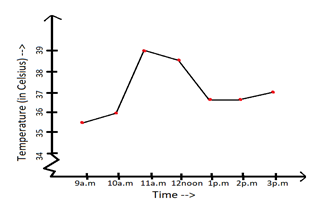
The patient’s temperature was the same for two times during the period given. What were those two times?

A) $1p.m$ and $2p.m$
B) $2p.m$ and $3p.m$
C) $12noon$ and $3p.m$
D) $9a.m$ and $10a.m$

Answer
555.3k+ views
Hint: In this question, we are given a line graph which denotes the temperature of a patient at different hours of the day. We have been asked to tell those two hours when his/her temperature was the same. Look for that period of time which has been connected by a straight horizontal line and not by an increasing or decreasing line. That period will be your answer.
Complete step by step solution:
We are given a line graph which denotes the temperature of a patient at different hours of the day. We have been asked to tell those two hours when his/her temperature was the same. We will start by noting down the temperature of the patient at the given hours.
$ \Rightarrow $$9a.m$=$35.5^\circ C$
$ \Rightarrow 10a.m = 36^\circ C$
$ \Rightarrow 11a.m = 39^\circ C$
$ \Rightarrow 12noon = 38.5^\circ C$
$ \Rightarrow 1p.m = 36.5^\circ C$
$ \Rightarrow 2p.m = 36.5^\circ C$
$ \Rightarrow 3p.m = 37^\circ C$
Now, as we can see that the temperature of the patient was the same at $1p.m$ and $2p.m$.
Option A is the correct answer.
Note: In the given question, we could also have used a shortcut method, wherein we check the two such points which are connected by a straight horizontal line. The logic behind this is that if the points are marked at the same levels, then joining them will give a straight horizontal line and not a vertical line as it arises when two points which are at different levels are joined.
In this question, we can notice that $1p.m$ and $2p.m$ are connected by a straight line and others are connected by vertical lines.
Complete step by step solution:
We are given a line graph which denotes the temperature of a patient at different hours of the day. We have been asked to tell those two hours when his/her temperature was the same. We will start by noting down the temperature of the patient at the given hours.
$ \Rightarrow $$9a.m$=$35.5^\circ C$
$ \Rightarrow 10a.m = 36^\circ C$
$ \Rightarrow 11a.m = 39^\circ C$
$ \Rightarrow 12noon = 38.5^\circ C$
$ \Rightarrow 1p.m = 36.5^\circ C$
$ \Rightarrow 2p.m = 36.5^\circ C$
$ \Rightarrow 3p.m = 37^\circ C$
Now, as we can see that the temperature of the patient was the same at $1p.m$ and $2p.m$.
Option A is the correct answer.
Note: In the given question, we could also have used a shortcut method, wherein we check the two such points which are connected by a straight horizontal line. The logic behind this is that if the points are marked at the same levels, then joining them will give a straight horizontal line and not a vertical line as it arises when two points which are at different levels are joined.
In this question, we can notice that $1p.m$ and $2p.m$ are connected by a straight line and others are connected by vertical lines.
Recently Updated Pages
Why are manures considered better than fertilizers class 11 biology CBSE

Find the coordinates of the midpoint of the line segment class 11 maths CBSE

Distinguish between static friction limiting friction class 11 physics CBSE

The Chairman of the constituent Assembly was A Jawaharlal class 11 social science CBSE

The first National Commission on Labour NCL submitted class 11 social science CBSE

Number of all subshell of n + l 7 is A 4 B 5 C 6 D class 11 chemistry CBSE

Trending doubts
What is meant by exothermic and endothermic reactions class 11 chemistry CBSE

10 examples of friction in our daily life

One Metric ton is equal to kg A 10000 B 1000 C 100 class 11 physics CBSE

1 Quintal is equal to a 110 kg b 10 kg c 100kg d 1000 class 11 physics CBSE

Difference Between Prokaryotic Cells and Eukaryotic Cells

What are Quantum numbers Explain the quantum number class 11 chemistry CBSE




